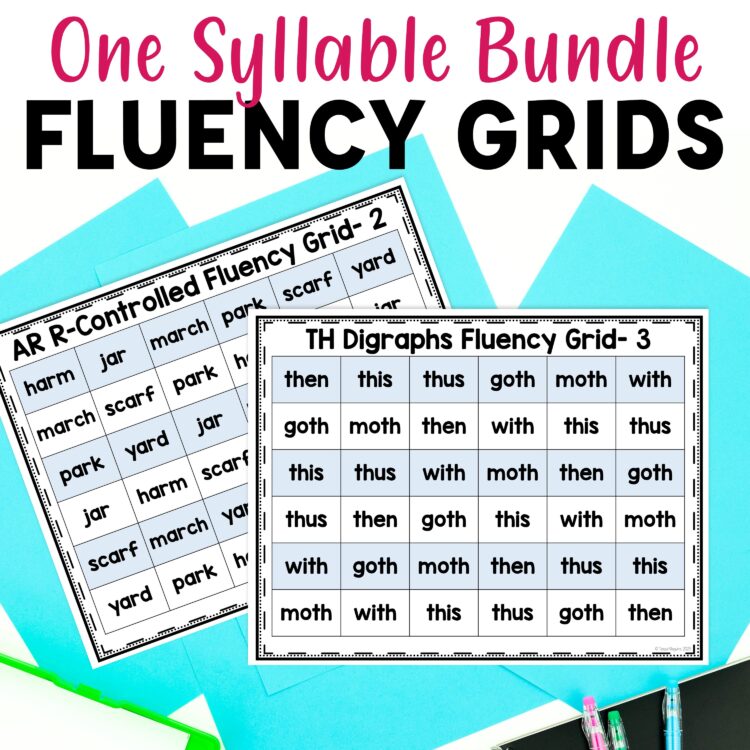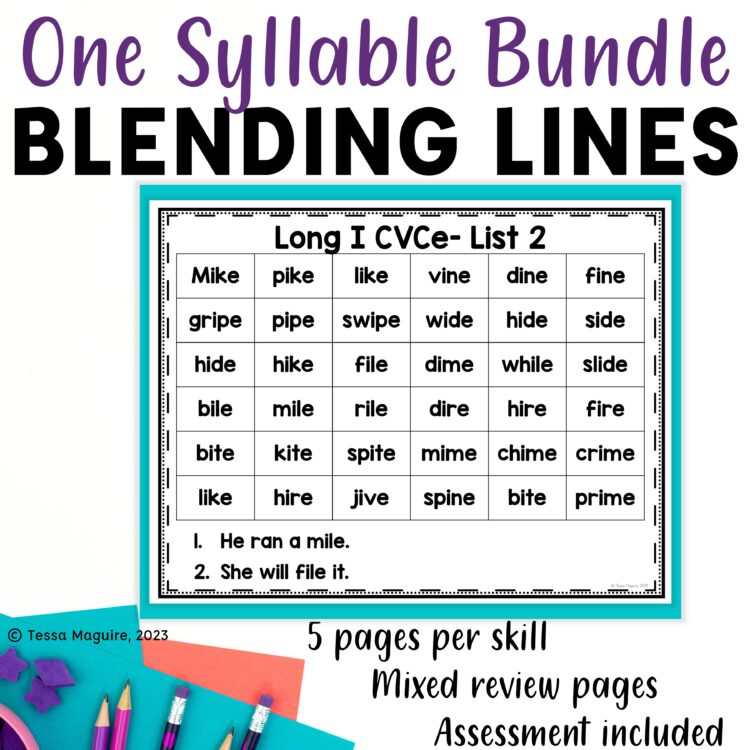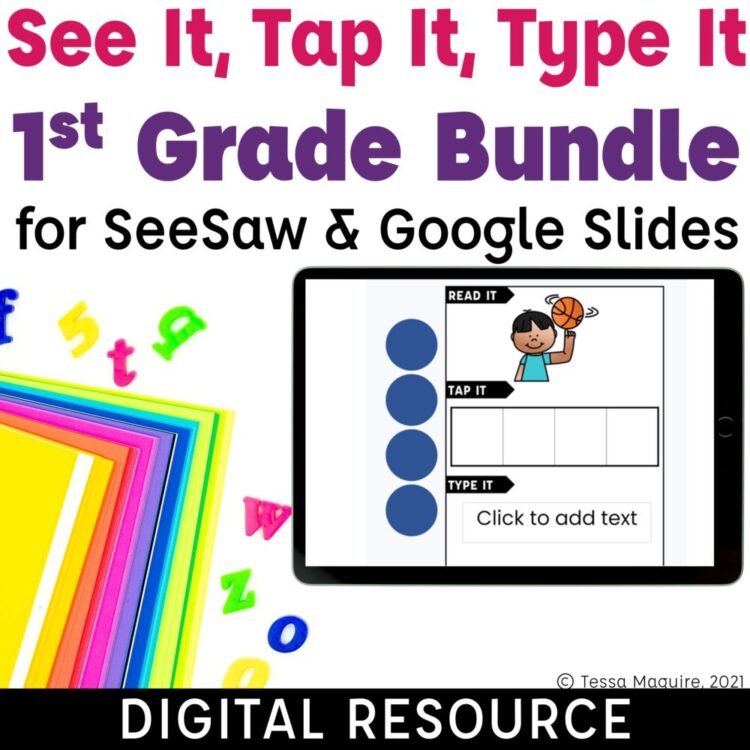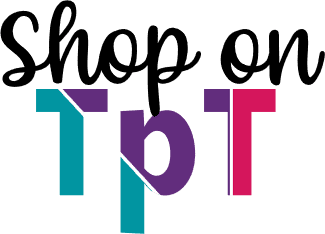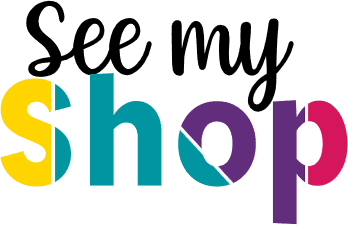© 2024 Tales from Outside the Classroom ● All Rights Reserved
Sight Words, High Frequency Words, and Heart Words, Oh My! Getting Started with SoR
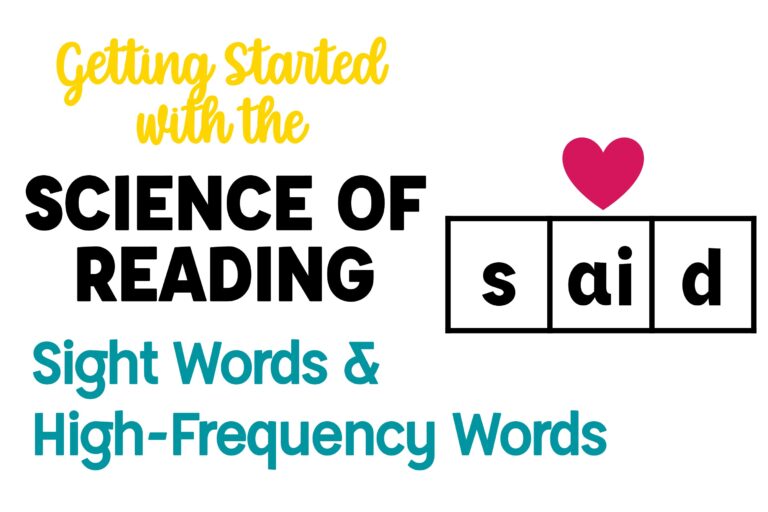
Today’s post is another area that can be confusing and deserves its own focus: sight words, high frequency words, and heart words. To really understand the science we need to be clear about the similarities and differences between each of these commonly used terms and clear up misconceptions. For starters, high-frequency words and sight words truly aren’t synonyms. Nor are sight words the words we need to memorize because they can’t be sounded out. Both of these misconceptions are widely held. Let’s take a look at some definitions and then let’s dig into the instructional implications on the best way to teach these words.
What are sight words?
A sight word is a word that is instantly and effortlessly recalled from memory, regardless of whether it is phonically regular or irregular. A sight-word vocabulary refers to the pool of words a student can effortlessly recognize. – Dr. David Kilpatrick
Sight words are words we know on sight, as the name suggests. They have been orthographically mapped for instant retrieval. They do not need to be decoded. Dr. Linnea Ehri has given us a lot of information regarding reading and sight words. My last post in the series talks all about orthographic mapping and goes a bit more in depth on that natural process.
Orthographic mapping involves the formation of letter-sound connections to bond the spellings, pronunciations, and meanings of specific words in memory. It explains how children learn to read words by sight, to spell words from memory, and to acquire vocabulary words from print. – Dr. Linnea Ehri
Sight words are not standard. For example, “cardiomyopathy” is not a sight word for me, and likely not for you. I need to decode it, though I am able to do it quite quickly. I recognize and use “cardio” to assist and then decode the word by syllables. My guess is, you did as well. Your brain connected what it sees and immediately connected your phonological, orthographic, semantic (meaning), and syntactic (context) systems to identify and understand it. You likely also recognized “cardio” and attributed it to the heart. You may have also used other portions of the word to help you decode it. But for many people it *is* a sight word because it’s a regular part of their oral language and they have seen it in print frequently. Cardiomyopathy is “heart disease” so any doctor and nurse knows it well.
We each have a unique orthographic lexicon (sight word memory) based on our own experiences that is quite large. There are certainly many words that overlap between us. Yet, there are also many unique words we know and understand based on the books we’ve read and the content we’ve studied. These words we know immediately are sight words.
What are high frequency words?
High frequency words are exactly what the name suggests: words that are in text frequently. Examples of high frequency words are: are, the, of, to, saw, said, here, etc. High-frequency words have been a focus for quite some time. There are two very popular high frequency word lists: Dolch and Fry. Each are commonly referred to as sight word lists, but they’re truly high frequency words. In fact, Dr. Fry named his list “Instant Words”. To give you an idea of how common these words are: Fry’s first 100 words make up over 50% of what we encounter in text. Because of their frequency, it’s important that students know these words quickly, leaving cognitive efforts to less common words. This is why both lists were developed by Dolch and Fry.
So why are things muddy? For quite some time, high frequency words have been referred to as sight words, hence both Dolch and Fry lists being named as sight word lists by educators often. It makes sense. We do want those high frequency words to become sight words. But calling them high frequency words helps things be more clear as to what we actually mean.
We absolutely want high frequency words to become sight words. We want to save students’ cognitive efforts for practicing phonics skills and for making meaning of texts. That doesn’t mean we need students to memorize them with flash cards or sight word lists, though. Keep reading.
Can high frequency words be sounded out?
This is a frequent misconception. I’ve seen some claim sight words are high-frequency words that are not phonetic, while high frequency words are. I’ve also seen some suggestions, given the history of the Dolch and Fry list, that we need to teach the high frequency words on those lists by whole word memorization since they’re not decodable. But, that’s not the most effective way to teaching them.
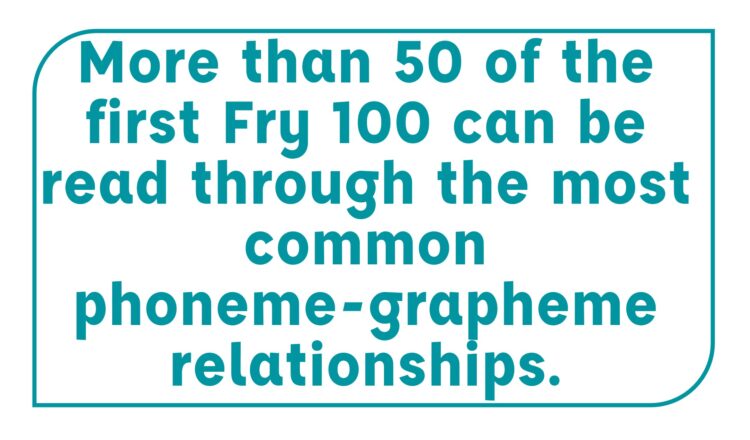
So, to answer the question, YES! Most high frequency words, truly most words, follow typical phonics conventions and can be sounded out just as any other word can. More than 50 of the first Fry 100 can be read through the most common phoneme-grapheme relationships. You may have heard these referred to as “flash words”. Some are quite simple: him, but, and yes are CVC words.
The complexity comes because many of them follow phonetic patterns that students are not yet familiar with before coming in contact with that high frequency word. For example: he, she, me, and go are all open syllables. Open syllables are often taught much later (or not at all) in a scope & sequence, and these words are quite frequent in beginning texts.
We don’t need to, and shouldn’t, teach high frequency words as whole words. Rather, we should focus students in on the phonics patterns in the words. More on that below.
So what are heart words?
You might have also heard about “heart words”. It is a fairly common term at this point, used as a synonym for high frequency words. More specifically though, heart words are an instructional strategy for teaching high-frequency words, especially those that don’t follow phonics conventions, or for patterns students have yet to learn. There are several high frequency words that have irregular phonics patterns: you, from, and want are just a few examples of heart words.
How do you teach high-frequency words?
There are probably 10-15 words that can be taught alongside initial phonics instruction- likely your letters instruction. This very small set of words enables students to read connected, decodable text fairly immediately. The words should be introduced one at a time with similar words separated (to and of, for example). Suggested words for this small list include: the, to, and, was, for, you, is, and of. Using rhymes or repetitive songs can help students learn these words by just their letter sequence. Additional words can be added based on the specific connected, decodable text you are using, but this initial list should be small.
After that. use your phonics scope & sequence to help guide you. We want to teach words with our phonics patterns as much as possible. We also still need to front-load high-frequency words outside of our phonics patterns. Regardless of the category for the high-frequency word, we should connect the word to its sounds, its spelling, and its meaning. By doing phoneme-grapheme mapping with students, we help students stop confusing similar words such as saw and was because we connect the letters to their sound sequences.
By incorporating phonetically regular high frequency words into our phonics instruction, and giving intentional practice with them, we help give students the opportunities to orthographically map these words for later retrieval. Words like big, but, him, and ran are likely going to be in students’ texts frequently. We can help students learn those words early in their learning by intentionally practicing with them during our phonics instruction with CVC words. Research says that new readers, those in the partial and early full phase, likely need at least 12 opportunities with a word for it to be orthographically mapped. By using these high-frequency words in our phonics lessons, intentionally, we can help students learn them quickly.
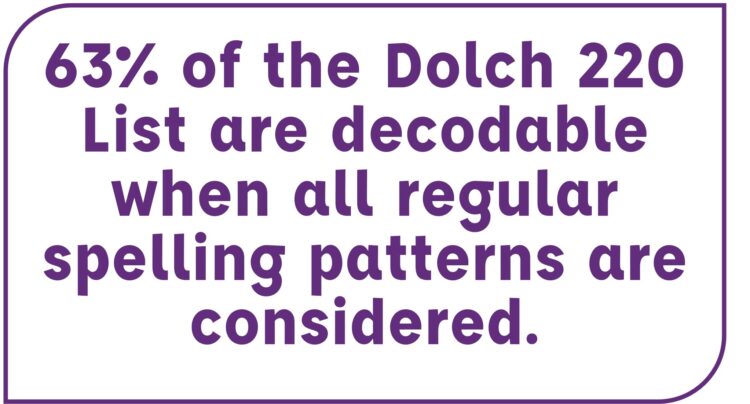
On A New Model for Teaching High Frequency Words by Linda Farrell, Michael Hunter, and Tina Osenga, the authors have laid out each of the Dolch 220 list by phonics skill. These easy to reference charts make it easy to align your sight word instruction with your phonics skills. It’s a great reference tool to help you plan out what words you’re teaching when.
Temporary Heart Words
As mentioned above, we also need to teach some high-frequency words outside of our phonics patterns. For these words, we want to group them together based on irregularity or phonics skill. When these words are grouped, we can help students learn the irregularity, even if it’s temporary. For example, “have” and “give” both are short vowel words where a final e is added since words do not end in “v”. These words should be taught while we’re teaching CVC words. We should also teach she, be, we, and me all together because it they’re open syllables. Because we’re already teaching open syllables with those words, it’s easy to then introduce go, so, and no, and likely even my and by at the same time or very near the same time.
We can teach one or two of these irregularities, along with the words included in that pattern, each week alongside our phonics instruction. Or, we can teach one or two truly irregular words. Be careful not to overload students and pace things out carefully and intentionally. A New Model for Teaching High Frequency Words also lists high-frequency words by irregularity for easy mapping for your year.
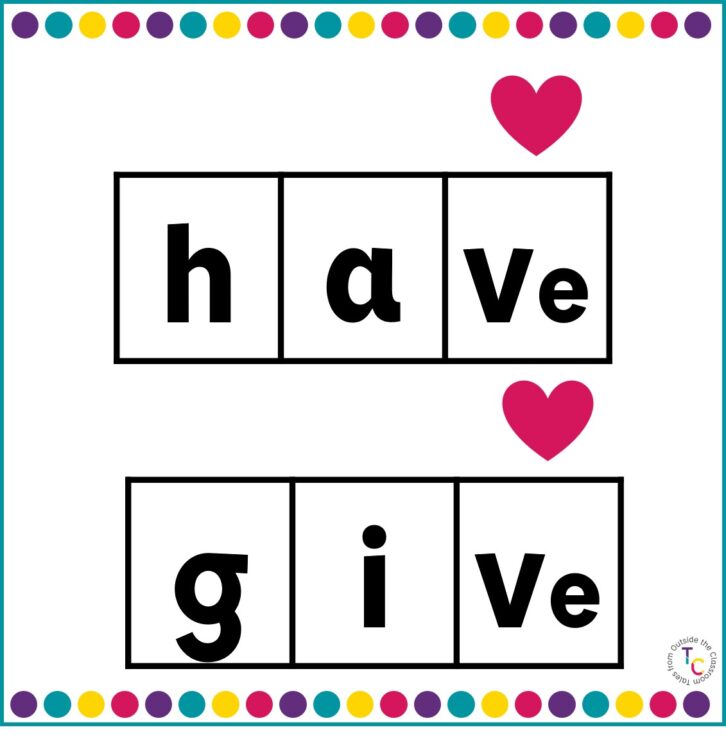
What about irregularly spelled words?
This is where the heart word method comes in! Some programs use the terms “tricky”, “criminal”, or “red” words to describe irregularly spelled words. Whether you choose to do “hearts” or something else, it’s important that we identify the unexpected spelling for students and cue them into the difference. These steps are the same steps we follow for temporary heart words as well. The difference with temporary heart words is that you should explicitly teach the unknown pattern, though the expectation isn’t that students be able to apply it elsewhere.
Steps for teaching irregularly spelled words:
- State the word and have students repeat it.
- Have students orally segment the word into its individual sounds. Represent the sounds with boxes or lines to “hold” each place.
- Spell the sounds calling attention to any unexpected, or not yet learned, spelling. You should cue the unexpected spelling but students can identify the expected sound-spelling relationships.
- Have students read the word and any related words, if applicable.
- Have students read connected, decodable text if possible. This could even be with a simple teacher-constructed sentence to ensure it’s decodability.
- Have students rewrite the word at least once. This writing can also be done with grapheme tiles, but research supports greater learning through students writing themselves.
UFLI has a great video on teaching high-frequency words following the heart word method.
Like all words, we should connect our high frequency word instruction with phoneme-grapheme relationships. Start by segmenting the word and counting its sounds. We want to go from speech to print (how the word sounds to how the word looks. You might draw lines for each of the sounds, or draw boxes. Or, if you can’t draw them, then use counters or another manipulative of some kind to move it into the box as you say each sound. Once the word is segmented, and the number of words are identified, then it’s time to spell it.
Let’s use the word “do” for example. Since “do” has already been identified as having two sounds, there should be two lines or boxes to build with. Going back to segmenting, the first sound in “do” is /d/. Identify the sound, ask students to give the letter that represents that sound, and then write it in the first box. The second sound is /oo/. Students likely don’t know the typical graphemes we use to represent that sound, so once students have orally identified it, then explicitly state “in this word, that /oo/ sound is represented by the letter “o” and we put it into the second box. This “irregular” sound should be explicitly identified and given as a cue for students. In the heart word method, a heart is placed above it to cue students into it being something they need to know “by heart”.
It’s important to focus on meaning, as well. The word can be read as part of decodable sentences, focused on the current or most recent phonics skills. Or, a decodable book with the sight word would also be great, but be sure the rest of the text is truly decodable for students.
Finally, students should have practice writing the word. After writing, students should read the word out loud to promote orthographic mapping. Students can trace, write, or build the word with magnetic letters or grapheme tiles.
The following resources are valuable for teaching high frequency words following the heart word method.
Really Great Reading has a great resource called Heart Word Magic. These easy to use animations focus on some of the highest utility high frequency words that are (even temporarily) irregular.
UFLI Foundations has printable irregular word cards (following the heart word method) that are available in the toolbox on their website.
UFLI Virtual Teaching Resources Hub: Irregular and High Frequency Words
For further reading on sight words & high-frequency words:
Should I Teach Students to Memorize Sight Words on Dr. Tim Shanahan’s blog
Sight Words & Orthographic Mapping on Reading Rockets
Want More on SoR?
Want to keep up as I explore key components of the Science of Reading? Get each post in the series your email by signing up below. First is my Introduction to the Science of Reading. After establishing some big picture ideas based on the science, I am diving into Scarborough’s Rope. I’m currently focused on the bottom strands: decoding. Join me on this journey by signing up below. Each week, I’ll email you a short email with a link to read the newest post.
Send me the SOR series!
Signup for to receive each installment in my Introduction to the Science of Reading series.
Thank you!
You have successfully joined our subscriber list. Please check your email for the confirmation email. Check your spam folder for Tales from Outside the Classroom if you don’t see it.
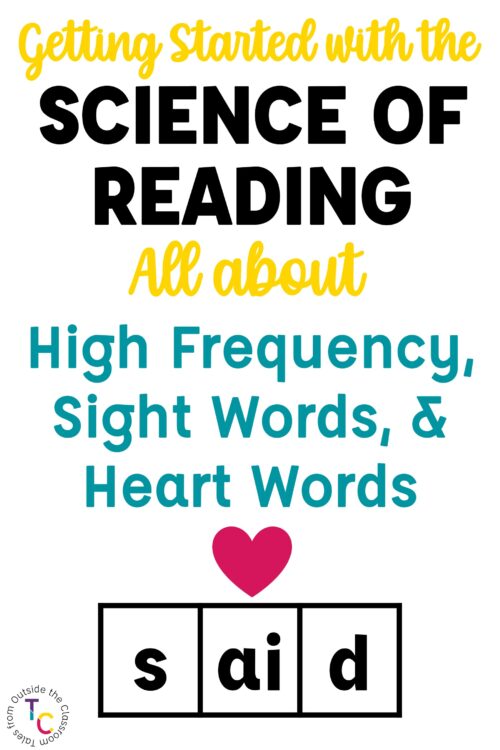
Newsletter Sign Up
Signup for my weekly-ish newsletter. I send out exclusive freebies, tips and strategies for your classroom, and more!
Please Read!
You have successfully joined our subscriber list. Please look in your e-mail and spam folder for Tales from Outside the Classroom. Often, the confirmation email gets overlooked and you're night signed up until you confirm!

Hi! I’m Tessa!
I’ve spent the last 15 years teaching in 1st, 2nd, and 3rd grades, and working beside elementary classrooms as an instructional coach and resource support. I’m passionate about math, literacy, and finding ways to make teachers’ days easier. I share from my experiences both in and out of the elementary classroom. Read more About Me.









